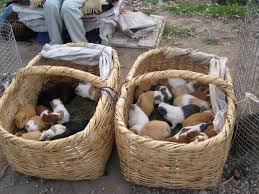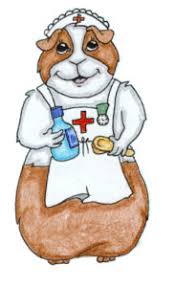Guinea Pig Breeding
The guinea pig is able to breed year-round, with birth
peaks usually coming in the spring; as many as five litters can be produced per
year. The gestation period lasts from 59–72 days, with an average of 63–68
days. Because of the long gestation period and the large size of the pups,
pregnant females may become large and egg plant-shaped, although the change in
size and shape varies. Newborn pups are well-developed with hair, teeth, claws,
and partial eyesight; they are immediately mobile, and begin eating solid food
immediately, though they continue to suckle. Litters yield 1–6 pups, with an
average of three; the largest recorded litter size is 17.
In smaller litters, difficulties may occur during labor due
to over-sized pups. Large litters result in higher incidences of stillbirth,
but because the pups are delivered at an advanced stage of development, lack of
access to the mother's milk has little effect on the mortality rate of
newborns. Co-habitating females assist in mothering duties if lactating.
 Male and female guinea pigs do not differ in external
appearance apart from general size. The position of the anus is very close to
the genitals in both sexes. Female genitals are distinguished by a Y-shaped configuration
formed from a vulval flap; while the male genitals may look similar with the
penis and anus forming a like shape, the penis will protrude if pressure is
applied to the surrounding hair. The male's testes may also be visible
externally from scrotal swelling.
Male and female guinea pigs do not differ in external
appearance apart from general size. The position of the anus is very close to
the genitals in both sexes. Female genitals are distinguished by a Y-shaped configuration
formed from a vulval flap; while the male genitals may look similar with the
penis and anus forming a like shape, the penis will protrude if pressure is
applied to the surrounding hair. The male's testes may also be visible
externally from scrotal swelling.
Males reach sexual maturity at 3–5 weeks; females can be
fertile as early as four weeks and can carry litters before they are adults.
Females that have never given birth may develop irreversible fusing of the
pubic symphysis, a joint in the pelvis, due to calcification which may occur
between 6 and 10 months of age. If they become pregnant after this has
happened, the birth canal will not widen sufficiently; this may lead to
dystocia and death as they attempt to give birth. Females can become pregnant
6–48 hours after giving birth, but it is not healthy for a female to be thus
constantly pregnant.
Toxemia of pregnancy is common and kills many pregnant
females. Signs of toxemia include anorexia, lack of energy, excessive
salivation, a sweet or fruity breath odor due to ketones, and seizures in
advanced cases. Pregnancy toxemia appears to be most common in hot climates.
Other serious complications of pregnancy can include a prolapsed uterus, hypocalcaemia,
and mastitis.
Diet

Grass is the guinea pigs natural diet. Their molars are
particularly suited for grinding plant matter, and grow continuously throughout
the animal's life. Most grass-eating mammals are quite large and have a long
digestive tract; while guinea pigs have much longer colons than most rodents,
they must also supplement their diet by coprophagy, the eating of their own
feces. However, they do not consume all their feces indiscriminately, but
produce special soft pellets, called cecotropes, which recycle B vitamins,
fiber, and bacteria required for proper digestion. The cecotropes (or caecal
pellets) are eaten directly from the anus, unless the guinea pig is pregnant or
obese. They share this behaviour with rabbits. In geriatric boars or sows (the
condition is rarer in young ones), the muscles which allow the softer pellets
to be expelled from the anus for consumption can become weak. This creates a
condition known as anal impaction, which prevents the boar from redigesting
cecotropes, though harder pellets may pass through the impacted mass. The
condition may be temporarily alleviated by carefully expelling the impacted
feces.

Guinea pigs benefit from feeding on fresh grass hay, such
as timothy hay, in addition to food pellets which are often based from timothy.
Alfalfa is also a popular food choice; most guinea pigs will eat large amounts
of alfalfa when offered it, though there exists some controversy over the
feeding of alfalfa to adult guinea pigs. Some pet owners and veterinary
organizations have advised that, as a legume rather than a grass hay, alfalfa
consumed in large amounts may lead to obesity, as well as bladder stones due to
excess calcium, in any but pregnant and very young guinea pigs. However, published
scientific sources mention alfalfa as a source for replenishment of protein,
amino acids, and fiber.

 Like humans, but unlike most other mammals, guinea pigs
cannot synthesize their own vitamin C and must obtain this vital nutrient from
food. If guinea pigs do not ingest enough vitamin C, they can suffer from
potentially fatal scurvy. Guinea pigs require about 10 mg of vitamin C daily
(20 mg if pregnant), which can be obtained through fresh, raw fruits and
vegetables (such as broccoli, apple, cabbage, carrot, celery, and spinach) or through
dietary supplements. Healthy diets for guinea pigs require a complex balance of
calcium, magnesium, phosphorus, potassium, and hydrogen ions; adequate amounts
of vitamins E, A, and D are also necessary. Imbalanced diets have been
associated with muscular dystrophy, metastatic calcification, difficulties with
pregnancy, vitamin deficiencies, and teeth problems. Guinea pigs tend to be
fickle eaters when it comes to fresh fruits and vegetables, having learned
early in life what is and is not appropriate to consume, and their habits are
difficult to change after maturity. They
do not respond well to sudden changes in diet; they may stop eating and starve
rather than accepting new food types. A
constant supply of hay or other food is generally recommended, as guinea pigs
feed continuously and may develop habits such as chewing on their own hair if
food is not present. Because guinea pigs' teeth grow constantly, they routinely
gnaw, lest their teeth become too large for their mouth, a common problem in
rodents. Guinea pigs will also chew on cloth, paper, plastic, and rubber.
Like humans, but unlike most other mammals, guinea pigs
cannot synthesize their own vitamin C and must obtain this vital nutrient from
food. If guinea pigs do not ingest enough vitamin C, they can suffer from
potentially fatal scurvy. Guinea pigs require about 10 mg of vitamin C daily
(20 mg if pregnant), which can be obtained through fresh, raw fruits and
vegetables (such as broccoli, apple, cabbage, carrot, celery, and spinach) or through
dietary supplements. Healthy diets for guinea pigs require a complex balance of
calcium, magnesium, phosphorus, potassium, and hydrogen ions; adequate amounts
of vitamins E, A, and D are also necessary. Imbalanced diets have been
associated with muscular dystrophy, metastatic calcification, difficulties with
pregnancy, vitamin deficiencies, and teeth problems. Guinea pigs tend to be
fickle eaters when it comes to fresh fruits and vegetables, having learned
early in life what is and is not appropriate to consume, and their habits are
difficult to change after maturity. They
do not respond well to sudden changes in diet; they may stop eating and starve
rather than accepting new food types. A
constant supply of hay or other food is generally recommended, as guinea pigs
feed continuously and may develop habits such as chewing on their own hair if
food is not present. Because guinea pigs' teeth grow constantly, they routinely
gnaw, lest their teeth become too large for their mouth, a common problem in
rodents. Guinea pigs will also chew on cloth, paper, plastic, and rubber.
 Health
Health
Common ailments in domestic guinea pigs include respiratory
tract infections, diarrhea, scurvy (vitamin C deficiency, typically
characterized by sluggishness), abscesses due to infection and infections
by lice, mites, or fungus.
Mange mites are a common cause of hair loss, and other
symptoms may also include excessive scratching, unusually aggressive behavior
when touched (due to pain), and, in some instances, seizures. Guinea pigs may
also suffer from "running lice" a small white insect which can be
seen moving through the hair; the eggs of these lice, which appear as black or
white specks attached to the hair, are sometimes referred to as "static
lice". Other causes of hair loss can be due to hormonal upsets caused by
underlying medical conditions such as ovarian cysts.
 Foreign bodies, especially small pieces of hay or straw,
can become lodged in the eyes of guinea pigs, resulting in excessive blinking,
tearing, and in some cases an opaque film over the eye due to corneal ulcer.
Hay or straw dust can also cause sneezing. While it is normal for guinea pigs
to sneeze periodically, frequent sneezing may be a symptom of pneumonia,
especially in response to atmospheric changes. Pneumonia may also be
accompanied by torticollis and can be fatal.
Foreign bodies, especially small pieces of hay or straw,
can become lodged in the eyes of guinea pigs, resulting in excessive blinking,
tearing, and in some cases an opaque film over the eye due to corneal ulcer.
Hay or straw dust can also cause sneezing. While it is normal for guinea pigs
to sneeze periodically, frequent sneezing may be a symptom of pneumonia,
especially in response to atmospheric changes. Pneumonia may also be
accompanied by torticollis and can be fatal.
Because the guinea pig has a stout, compact body, the
animal more easily tolerates excessive cold than excessive heat. Its normal
body temperature is 101–104 °F (38–40 °C), and so it’s ideal ambient air
temperature range is similar to the human's, about 65–75 °F (18–24 °C).
Guinea pigs are prey animals whose survival instinct is to
mask pain and signs of illness, and many times health problems may not be
apparent until a condition is severe or in its advanced stages. Treatment of
disease is made more difficult by the extreme sensitivity guinea pigs have to
most antibiotics, including penicillin, which kill off the intestinal flora and
quickly bring on episodes of diarrhea and in some cases, death.
Pets
If handled correctly early in their life, guinea pigs
become amenable to being picked up and carried, and seldom bite or scratch.
They are timid explorers and often hesitate to attempt an escape from their
cage even when an opportunity presents itself. Still, they show considerable
curiosity when allowed to walk freely, especially in familiar and safe terrain.
Guinea pigs that become familiar with their owner will whistle on the owner's
approach; they will also learn to whistle in response to the rustling of
plastic bags or the opening of refrigerator doors, where their food is most
commonly stored.
Guinea pigs should be kept in pairs or, preferably groups,
unless there is a specific medical condition that requires isolation. Lone
guinea pigs are more likely to suffer from stress and depression. These varieties vary in hair and
color composition.
 Heartgard Chewable is a flavored
treatment for dogs given once a month to prevent heartworms. Heartgard Chewable
requires a prescription from your veterinarian.
Heartgard Chewable is a flavored
treatment for dogs given once a month to prevent heartworms. Heartgard Chewable
requires a prescription from your veterinarian.











